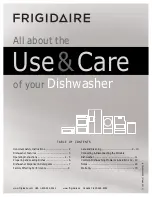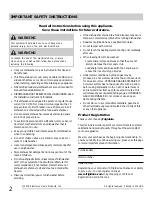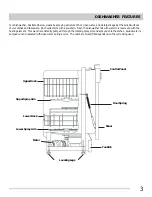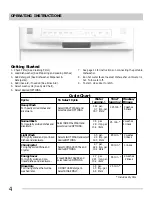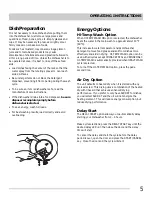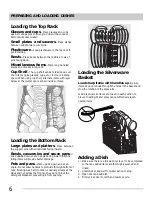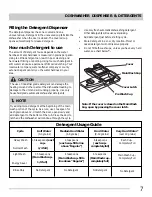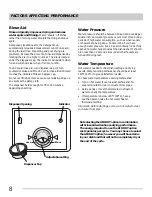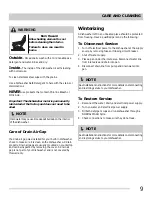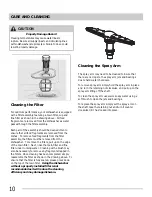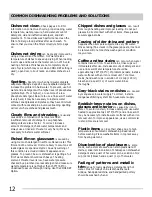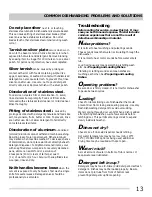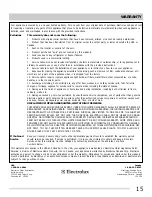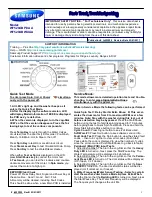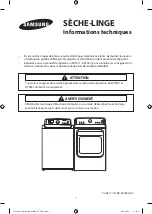
12
Dishes not clean
—Check pages 4 to 8 for
information on correct wash cycle, proper loading, water
temperature, water pressure, hard water, amount of
detergent, old and ineffective detergent, and dish
placement. To maximize wash performance clean the
filter of all large food particles after each wash. To
ensure that you clean the filter correctly refer to page
12.
Dishes not drying
can be greatly improved by
using a rinse aid and hot water. Hot water raises
temperature of dishes to speed up drying. When loading,
invert cups and bowls so that water can run off. Avoid
nesting of articles. If dishes are not completely dry at
end of cycle (which may occur when COOL DRY setting is
used), open door, roll out racks, and allow dishes to air
dry.
Spotting
—Spots form when hard water droplets
evaporate leaving a deposit. Low phosphate detergents
increase the problem in hard water. To prevent, use hot
water and a detergent with a higher level of phosphates
(preferably 8.7% or higher), or use more of a low
phosphate detergent. Be sure to use a rinse aid. If water
is very hard, it may be necessary to install a water
softener. Load glasses and plates so they have minimum
contact with racks and pins. Avoid overloading. Spotting
will occur where dishes and glasses touch.
Cloudy films and streaking
are usually
caused by a combination of hard water and an
insufficient amount of detergent. Low phosphate
detergents are also a factor. To correct, increase
amount of detergent, check water temperature and
always use a rinse aid. If water is very hard, it may be
necessary to install a water softener.
Etched film on glassware
is caused by
using too much detergent in soft or softened water. This
film cannot be removed. It is more likely to occur on soft
leaded glass or expensive crystal. An early warning of
this condition is a cloudy iridescent appearance on
glasses. To prevent, be sure dishwasher is getting a full
fill of water. Water should reach base of heating
element. If water level is low, have water pressure
checked by a plumber. Use less detergent and make sure
water temperature is not higher than 150°F (66°C).
Underload to assure thorough rinsing. Use the COOL DRY
Option.
Chipped dishes and glasses
can result
from rough handling and improper loading. Do not put
glasses in direct contact with other items. Place glasses
securely against pins.
Crazing of older china and pottery
happens when items are subjected to very hot water.
Once crazing (fine cracks in the glaze) appears, it cannot
be removed. Do not machine wash again or condition
may worsen.
Coffee and tea stains
can occur when water
contains traces of iron. To avoid stains, rinse cups out
immediately after use. Increase amount of detergent and
use a rinse aid. Water temperature should be
approximately 140°F (60°C). If problem persists, install a
water softener with an iron removal unit. To remove
stains, hand wash cups in solution of 1/2 cup (120 ml)
bleach and a quart (1 L) of warm water. Rinse
thoroughly.
Gray-black stains on dishes
are caused
by manganese in water supply. To correct, install a
manganese filtering system into house water supply.
Reddish-brown stains on dishes,
glasses and interior
are caused by iron in
water. To avoid iron stain, increase detergent, use water
heated to approximately 140°F (60°C) and a rinse aid. It
may be necessary to install a water softener with an iron
removal unit. To improve appearance, use a commercial
rust and lime scale remover.
Plastic items
can lose their shape due to high
temperatures of automatic dishwashing. Read labels
before washing. Place washable items in top rack away
from heating element.
Discoloration of plasticware
by some
foods, such as tomato sauce, can stain plasticware. If
stained, soak item in solution of 1 tablespoon dishwasher
detergent and a quart of hot water or in a solution of 1/2
cup (120 ml) bleach and a quart (1 L) of hot water.
Fading of patterns and metallic
trim
is due to many washings, detergent and hot
water. Most of today’s china is dishwasher safe.
Antique, handpainted china, and handpainted pottery
should be washed by hand.
COMMON DISHWASHING PROBLEMS AND SOLUTIONS
Summary of Contents for FFBD1821M S
Page 14: ...14 NOTES ...
Page 16: ......

